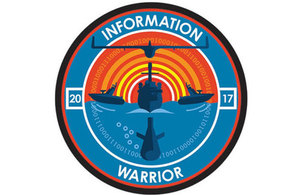Information - The King of Modern War!
Information technology has transformed the modern battlefield giving the UK’s armed forces a battle winning advantage.

Stalin was wrong! Artillery is no longer the King of War. Information technology has transformed the modern battlefield at sea, in the air and on land, and it is arguably the new King of War. In April the Defence Science and Technology Laboratory (Dstl) will help to demonstrate this as part of the Royal Navy led Information Warrior exercise.
Information Warrior builds on the impressive success of last year’s Unmanned Warrior exercise. It focuses is on how information can be used offensively and defensively to give the UK’s armed forces a battle winning advantage.
As part of the Royal Navy’s Project X programme, Dstl is working on smaller, more agile and user-friendly secure communications. This will enable new concepts of operations by delivering greater situational awareness. The Royal Marines will put this system to the test during the exercise to ensure that it allows their command to communicate effectively with troops on the ground.
Dstl’s Open Architecture Combat System (OACS) is another enabling technology, making it much easier for new applications – developed by a wide range of providers - to be integrated into ships’ combat systems. OACS underpinned the success of Unmanned Warrior 16, and will be used during Information Warrior to allow artificial intelligence applications such as STARTLE to be deployed.
Artificial intelligence (AI) is a major theme of Information Warrior. One of the first potential applications of AI is STARTLE. This uses AI-based reasoning to help operators analyse air movements to identify potential threats in seconds. Other Dstl projects will apply AI and Big Data to enhance the analysis of imagery from Unmanned Aerial Vehicles to assess potential landing sites and routes to support landing forces.
Cyber resilience is another major theme. Dstl’s technical experts are supporting the RN to ensure that its forces are secure and resilient to cyber threats, in accordance with the national cyber security strategy. Consequently, Information Warrior will exercise the Royal Navy’s ability to defend itself against cyber threats, as well as conventional threats, ensuring that our cyber defences and skills remain state of the art in this rapidly evolving area.
Better information exploitation (IX) is another priority for Information Warrior. Dstl’s support in this area includes the Adaptive Tactical Information eXploitation (ATIX) and Every Platform A Sensor (EPAS) projects. ATIX uses all the available data sources, applying data analytics, machine learning and statistics to improve the commanders’ understanding of complex situations. This enables them to make more effective decisions. Currently much of the data gathered by sensors is not used. EPAS will address this by extracting useful information on events, such as ship tracks, from every available source. This builds a comprehensive store of data that can be analysed in real time, or at a later date.
Discussing Information Warrior, Dstl’s Chief Executive, Jonathan Lyle, said:
“Information has transformed the face of conflict. Dstl is excited to be part of the Royal Navy’s Information Warrior exercise – in which our scientists will be demonstrating and testing some of the latest innovations in cyber, information systems, Big Data and artificial intelligence research.”
Regular updates on the progress of the Information Warrior exercise can be found on the Royal Navy’s website.
Dstl media enquiries
Email DstlPress@dstl.gov.uk
Press office 01980 950000 option 2